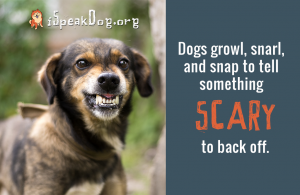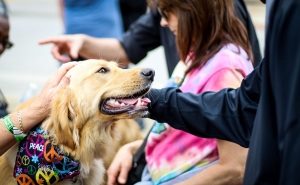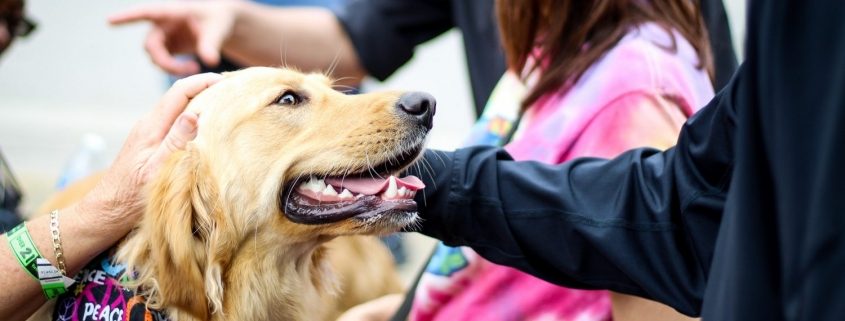Ask Crystal: Responding to Growling
Welcome to “Ask Crystal,” where you can ask your pet behavior questions! You can submit your question for Crystal at the bottom of the page!
Dear Crystal,
We just adopted a dog a few days ago and we are concerned about some behaviors that we have seen. We took her a party at a family member’s house the day we brought her home and she was growling at some people there that were singing loudly. When we yelled at her to stop, she growled at us. Then a day or so after when we had some friends over with their dogs and she was growling at their dogs. I didn’t want to adopt an aggressive dog. What can we do to teach her not to growl?
Sincerely,
Grumpy Dog Owner
Dear Grumpy,
I can certainly understand why you and your dog both might be grumpy at the situation. I can help you look at it from the dog’s point of view. The first step to changing a dog’s behavior is understanding more about what they are trying to tell you. Aggression is not a personality trait but rather a description of a type of behavior. Why is the dog behaving that way and how can we make things better for them? When a dog growls at someone or something, it is their way of saying that they need more space. There are often subtler signals being given by the dog prior to growling. I would highly suggest that you start brushing up on your dog body language. A wonderful resource to check out is www.ispeakdog.com.  As you start to learn the signs of fear or stress, you will be able to recognize discomfort prior to growling in some situations. While it is upsetting to see our dogs growl, they are growling for a reason. Usually the reason a dog is growling is related to fear. If a dog is feeling afraid then yelling at her is likely to make her feel even more so. It is very critical that you not punish your dog for growling. If we punish the means of warning in a dog, we can get a dog that bites without warning. You haven’t changed the internal state just suppressed the dog from telling you how she feels. Instead, we should listen to what they are telling us, move them further away from the trigger or remove them from the situation entirely. Once we have a better picture of what exactly is going on, we can work on any fear issues they may have.
As you start to learn the signs of fear or stress, you will be able to recognize discomfort prior to growling in some situations. While it is upsetting to see our dogs growl, they are growling for a reason. Usually the reason a dog is growling is related to fear. If a dog is feeling afraid then yelling at her is likely to make her feel even more so. It is very critical that you not punish your dog for growling. If we punish the means of warning in a dog, we can get a dog that bites without warning. You haven’t changed the internal state just suppressed the dog from telling you how she feels. Instead, we should listen to what they are telling us, move them further away from the trigger or remove them from the situation entirely. Once we have a better picture of what exactly is going on, we can work on any fear issues they may have.
When you get a new animal, there needs to be a decompression period. Depending on the dog, this decompression period could be a few days, a few weeks or in extreme cases months. We suggest two weeks to most people but pay attention to your dog to let you know when they are settled in. Most people know that dogs in animal shelters have been through a lot of stress, but they don’t seem to understand how long that stress can linger in the dog’s body and that stress influences their behavior strongly. Imagine yourself on your worst day and how sensitive you might feel to the stimulus in your life. Also, all the fun things that we want to do with our new dogs can be very overwhelming and stressful to them. Remember that they don’t know you or their new house or any of the routines.

To put yourself in their shoes, imagine you get taken away by an alien species and they put you in their spaceship. They are trying to speak to you, but you don’t understand the language. They bring more aliens over to look at you. They all start hugging and kissing you. That might be a little frightening to any of us. It is a possibility that your new dog may not have that big of a problem with new people or dogs. You may have just exposed her to a lot of new things at a time when she was already feeling overwhelmed.
To help a dog settle in, keep their world very small for a couple weeks. This means either no walks or very short neighborhood walks to potty. I would suggest setting up a crate to give her a quiet space to retreat to in a dog proof room. Don’t close the door on the crate until you have really spent some time acclimating her to staying in a crate. Keep her on a leash next to you when you are home and have her out. This will keep her from having more freedom than she needs right now and help the bonding process. I also suggest hand feeding any new dog to help them bond to you. Please refrain from taking her anywhere else or having anyone over until she seems to be getting more comfortable and relaxed.
When thinking about the proper way to introduce your dog to new dogs, it can vary from dog to dog but I always like to err on the side of caution and go very slowly with introductions. I would also suggest that some dogs may need a little more space and time to get used to new dogs. Just like you don’t like everyone you meet your dog might be the same. A lot of dogs are very dog social as puppies but start to become more selective as they get older. I think it is a fabulous idea for a dog to have a group of dog friends that they play with on a regular basis. This is going to be a lot less stressful for most dogs than a dog park. To get your dog off on the right paw with new dogs, I would suggest just taking a few long walks with any potential new dog friends. Walk the two dogs near each other without touching. If either dog is barking or growling, then you need to give the dogs more space so walk further apart until they calm down. When we let them greet, we want both dogs to be calm and relaxed. I suggest that the initial greeting be no more than three seconds and then keep walking. Three seconds isn’t long enough for anything to happen usually so it’s just fast enough to say hello and keep safe. Once you are able to let them interact safely, I would suggest making any playtime outside only and closely monitor. We want to stop play frequently to keep it from going over the top and becoming a disagreement. Limit your playtimes to no more than 15 minutes to keep it positive and have them both wanting more.
You may find once you have given her the proper decompression time that some of the behaviors are not happening any more. If you do find that she has some fear issues with some people or dogs, then I would suggest that you contact a certified dog trainer to work on getting her past her fears. You can find a list here. We want to avoid using any aversive techniques with fearful dogs so look for a trainer that uses force- and fear-free methods.
Until next time,
Crystal







